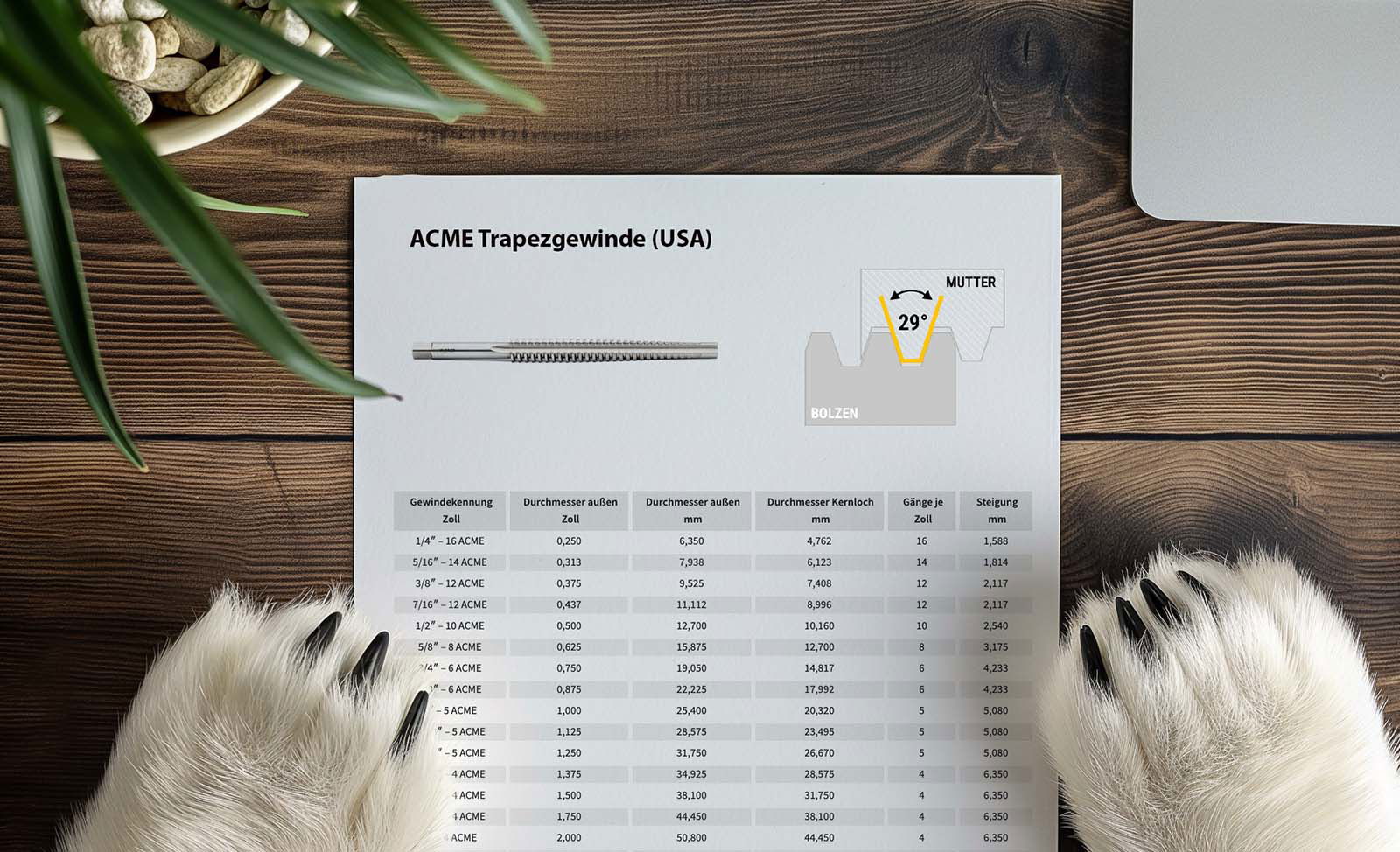
The ACME thread: American trapezoidal thread
If you frequently work with threads, you've likely come across this name: ACME. It refers to the American Trapezoidal Thread and is, by the way, not an abbreviation as often assumed. In fact, it was the Acme Screw Machine Company that developed the ACME thread in 1894, long before it became a national standard in 1921. While the company is history, the ACME thread has not only survived to this day but has also made a remarkable journey. While metric variants have become dominant for many other types of threads worldwide, the inch-based ACME thread remains the international leader among trapezoidal threads. That's why it's high time to take a closer look at the American Trapezoidal Thread and answer the question of whether you should invest in ACME thread taps!
Features of the ACME Thread
The ACME Trapezoidal Thread is similar to the metric trapezoidal thread but has some unique features. Here are the details:
The Correct ACME Thread Designation
In addition to the spelling ACME thread, you may also come across the variant Acme thread frequently. Strictly speaking, the second spelling is correct since it is not an abbreviation. However, both options are now firmly established. For the thread designation, you need to specify the nominal diameter in inches and the pitch in threads per inch for the ACME thread. So, a thread with the designation 7/8″ – 6 ACME is an ACME Trapezoidal Thread with a 7/8″ outer diameter and a pitch of 6 threads per inch.
The ACME Thread is a Trapezoidal Thread
Trapezoidal threads are identified by their trapezoidal profile. In the case of the ACME Trapezoidal Thread, this is defined by a flank angle of 29° and a thread height equal to half the pitch – at least for the general-purpose thread. The distinctive shape with wide threads makes the thread very robust and provides higher resistance to contamination. Additionally, American Trapezoidal threads can be manufactured with a single or multiple threads.
ACME Trapezoidal Threads are Mostly Motion Threads
ACME Trapezoidal threads are commonly used as motion threads. Unlike fastening threads, they are designed to transmit force rather than create a firm hold. It is often about converting a rotational motion into axial motion. Consequently, Trapezoidal threads are frequently found on rotating and lifting spindles, where they are essential for the operation of lathes, milling machines, and presses.
The ACME Thread Comes in Three Variants
Even though only two types of the American Trapezoidal Thread are commonly listed – namely the regular version and the STUB variant – there are actually three different forms.
- The General Purpose ACME Thread for normal applications
- The Centralizing ACME Thread with tighter tolerances
- The STUB ACME Thread with lower thread height
The General Purpose ACME Thread is sometimes marked with the abbreviation GP and is the standard version of the thread suitable for all applications that do not have special requirements for a thread.
The Centralizing ACME Thread is identical to the GP but has tighter tolerances on the outer diameter of the internal and external threads. It is mainly used in feed spindles, where the tight tolerances help maintain the alignment of the thread axis. For example, it can prevent wedging on the thread flanks if a long spindle sags between two supports.
Finally, there is the STUB ACME Thread with a lower thread depth. It is used whenever the thread depth matters, such as in components with thin walls where excessive thread depth would compromise stability.
Distinguishing the ACME Thread from the Metric Trapezoidal Thread
At first glance, the American Trapezoidal Thread can be easily confused with the metric one. Both trapezoidal threads are very similar in their geometry and are used for similar applications. However, they are not interchangeable.
American and metric Trapezoidal threads have different flank angles
The most obvious difference between the American and the European metric Trapezoidal thread is the flank angle. The metric thread has a flank angle of 30°, while the ACME thread has a flank angle of 29°. Similar but not identical. The slight deviation can be attributed to the fact that the ACME Trapezoidal thread was designed based on inch-based values, bringing us to the next point…
The ACME Trapezoidal Thread can be distinguished from the metric thread by the unit of measurement
The common Trapezoidal thread in Europe is a metric thread. This means that the Trapezoidal thread according to DIN standard uses millimeters, while the American thread uses inches for all measurements. Both Trapezoidal thread types were designed so that straightforward values in their respective unit systems can be used for easy work. As a result, the thread tables for American and metric Trapezoidal threads differ significantly.
Regional differences between American Trapezoidal thread and metric counterpart
While all Trapezoidal threads are used for similar purposes, they are not used everywhere in the world. While the metric variant is widespread in Europe, the ACME thread has the upper hand in the rest of the world.
Do You Need an ACME Thread Tap?
As always, the most important question comes last: Is it worth having an ACME thread tap in your workshop? This primarily depends on your field of work. Although the metric Trapezoidal thread is predominantly used in Germany, the American Trapezoidal thread is the standard in many countries, especially in non-European countries and the USA. So, if you work with components from outside Europe and especially the USA or vice versa, you may often need an ACME thread tap. If this is not the case for you, a metric thread tap will usually suffice.
When looking for the right tap, BAER, as a tap manufacturer, is your go-to partner. Feel free to browse our online shop at any time or contact our customer service!
